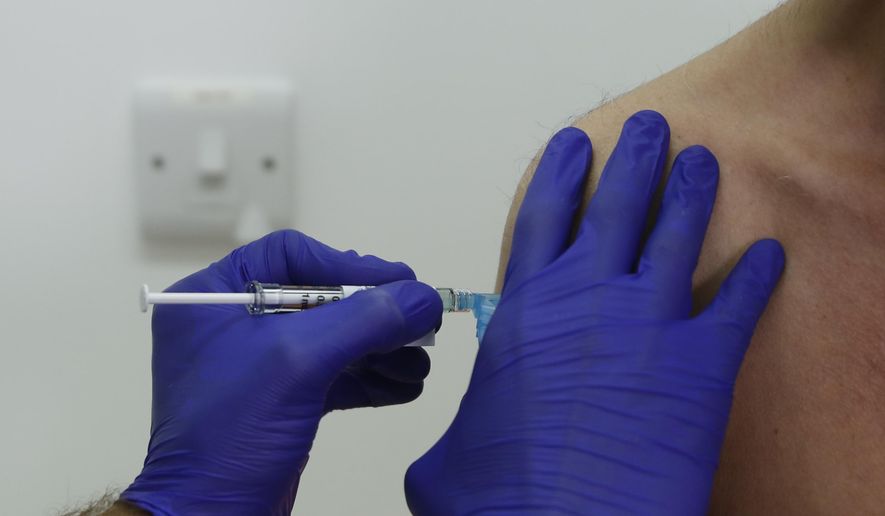Maryland drugmaker Novavax is playing catch-up in the COVID-19 vaccine race but feels it can sway the vaccine-hesitant and serve the long-term booster market when U.S. regulators give the green light to its shots.
The Food and Drug Administration scheduled a June 7 advisory meeting to consider Novavax’s request for emergency use. The session should set the table for regulatory authorization, expanding the menu of coronavirus vaccines beyond the trinity that’s been used since early 2021.
Two-thirds of Americans are fully vaccinated against COVID-19 but there’s been little progress in increasing that share, so Novavax officials are betting their protein-based vaccine will be attractive to those who are leery of dominant options that rely on messenger RNA. Until this pandemic, mRNA vaccines had never been deployed on a wide scale.
“While the mRNA vaccines have done a tremendous job in making vaccine available quickly to the U.S., there still remain vaccine-hesitant [people],” said John Trizzino, chief commercial officer at Novavax. “There still remain folks that would prefer a different vaccine and prefer a protein-based vaccine. So this is in support of that consumer choice.”
Novavax is seeking authorization as a primary vaccine that is given in two doses, 21 days apart, for persons 18 and older. It is gathering data on booster doses, either as a follow-up to its vaccine or to mix-and-match with mRNA shots. The virus isn’t going away, and experts believe the public is destined for annual shots.
Novavax is also testing its vaccine in adolescents and younger children, hoping to tap into those markets.
SEE ALSO: Biden launches first federal test-to-treat site for COVID-19
“I think there is significant opportunity, both short-term and long-term, in the U.S.,” Mr. Trizzino said.
The vaccine showed 90% efficacy against symptomatic infection in studies against the original strain and early variants, putting it roughly on par with the mRNA vaccines’ initial results.
Notably, the Novavax vaccine was not tested in trials against the omicron variant. The company said immune-response tests found a third shot could spur protection against omicron and, like other companies, it is working on an omicron-specific shot ahead of a likely fall booster campaign.
The U.S. vaccine campaign settled on three options early on — two-dose regimens from Pfizer-BioNTech and Moderna, which use mRNA, and a one-shot version from Johnson & Johnson that uses an adenovirus platform.
The mRNA vaccines, which instruct the body to recognize and attack the coronavirus, were the first to win authorization and became the dominant options for primary vaccination and booster shots.
The J&J version became available in early 2021 but struggled to gain traction due to manufacturing issues and concerns about a rare blood-clotting condition. Earlier this month, the FDA said it is limiting the use of the J&J vaccine to adults who cannot access another version or might face a medical issue if they take another type.
Novavax was among six companies in the Trump administration’s Operation Warp Speed effort to create a vaccine in record time. It received $1.8 billion in taxpayer funding for the development of its vaccine, which takes genes to create an antigen (the spike protein for the coronavirus) and puts them into an insect virus that infects moth cells and replicates, creating plenty of spike proteins.
It uses an adjuvant, which enhances the body’s immune response to an antigen, that’s derived from a kind of tree bark that grows in South America.
The spike proteins are purified and delivered by needle right into the body instead of forcing the body to create and recognize the spikes.
“It’s classic vaccine technology,” said Filip Dubovsky, chief medical officer for Novovax, noting similar technology is used against hepatitis B, shingles and other conditions. “People may well find that reassuring.”
Paul Mango, the deputy chief of staff for policy at the Department of Health and Human Services in the Trump administration, said Novavax could carve out a niche in the market if its safety and efficacy profile is strong and if it proves to offer more durable immunity than mRNA vaccines.
“Its vaccine is based on a protein sub-unit technology, which has been used for decades and the medical community has a lot of confidence in this technology,” Mr. Mango, who played a key role in Operation Warp Speed, told The Washington Times. “Novovax might be able to exploit this if it mounts a strong, physician-oriented marketing campaign.”
The Novavax vaccine has been authorized for use in 41 countries and the company has delivered more than 40 million doses. But it is far behind other options because of manufacturing problems.
Mr. Mango said the company had trouble scaling up from 5-liter batches to 2,000-liter batches. Plus, protein-based vaccines require high purity ratings.
“Novovax was struggling on this dimension, although it was making steady improvements throughout the fall of 2020,” he said.
The company said it is confident in its manufacturing abilities, and its vaccine can be stored at normal refrigeration temperatures, making it attractive to global markets that struggle with the ultra-cold requirements needed to preserve mRNA shots.
Some experts, though, say alternatives to mRNA already exist.
Dr. Peter Hotez said he invented “an as-good or better protein-based vaccine” with colleagues at the Baylor College of Medicine in Texas.
Developed with only $400,000 in taxpayer money, the low-cost shot is being made by an Indian company, Biological E, and about 45 million shots have been delivered in India at a cost of $1.86 per shot.
Dr. Hotez said they are waiting for pre-qualification from the World Health Organization for broader global use and that the U.S. government hasn’t shown much interest as it focuses on mRNA options.
Rep. Lizzie Fletcher, Texas Democrat, nominated Dr. Hotez and Dr. Maria Elena Bottazzi for the Nobel Prize for developing an inexpensive vaccine.
For more information, visit The Washington Times COVID-19 resource page.
• Tom Howell Jr. can be reached at thowell@washingtontimes.com.




Please read our comment policy before commenting.